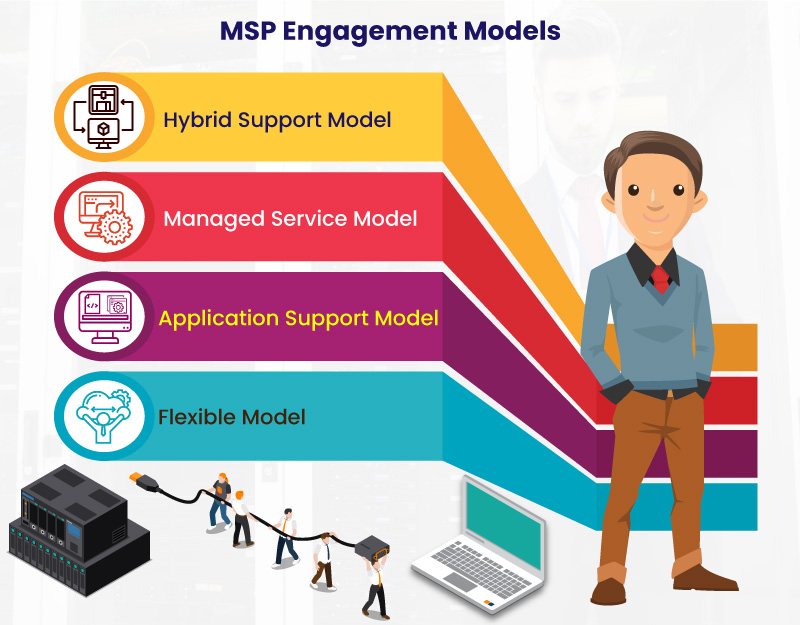
If you have a strong IT department full of talented and creative whizzes who can do wonder with codes, would the best utilization of their time be to maintain or fix run-of-the-mill glitches? By breaking free from this cycle, you would be surprised to know that an IT team can be a revenue churner through innovation, expertise, and brainpower.
Transitioning from the 90’s break/fix system
To remedy this, organizations can now choose to outsource their IT systems to external providers for managing daily IT processes, overall security, and infrastructure. Managed IT Services Delivery model is a great way to address the day-to-day maintenance issues and improve business operations while leaving ample time for the organization to focus on its core issues and path to development.
Through this model, Managed Service Providers (MSPs) can take upon the daily functioning, and responsibility of a business’s IT process from a remote location through Cloud. Ranging from network monitoring to combating cybersecurity threats, MSPs offer various packages that can be customized as per business needs.
What makes Managed IT Services a popular choice?
- Stay top of your game – Hiring a managed IT service provider brings the table expert IT staff without having to invest in hiring or training any resources.
- Keeping it central – An organization can run the servers and applications centrally from a managed data center, ensuring higher employee performance and access to virtual services.
- Strategy-ready – Through managed services, it is easy to think in advance as the MSP offers advice on any new infrastructure required, upgrades to be done and prepare systems to combat viruses and crashes.
- Outsourced team – Another benefit of managed services is complete access to a fully up and running IT department. It comprises an IT manager and a virtual CIO who develops a game plan and roadmap to figure out how the IT wing complements your organization.
Things to consider while leveraging Managed IT Services
While making a move to managed services arrangement, here are a few things to keep at the top of your mind:
- Accountability – The prime reason to opt for Managed IT Service is to improve operational efficiency and minimize the IT issues that hamper your organization’s progress. Hence, it is vital to ensure that the MSPs are accountable and delivering consistently on bringing about improvements. A great idea to track progress would be asking for regular reports and analytics to understand how their work is bringing about change and causing progress.
- Track record – Before signing up a contract with an MSP, it is important to run a background or record check to ensure they can deliver quality outcomes and offer proactive services. Try and check their references, find out the clientele they already have, and their journey with these companies.
- Pricing – Opt for an MSP that offers flexible pricing options and transparency in dealings. Whether it is implementation or migration of applications, choose an MSP that offers end-to-end services at customized packages.
How to choose the right MSP?

Did you know that the managed service providers market will increase in worth to USD 257.84 billion by 2020? If you want to be a part of this scenario after considering the pros and cons of Managed IT Services, if you are contemplating finding the right MSP, then it is crucial to keep in mind the size of the MSP model and decide upon the apt pricing model.
Here are a few types of MSPs you could opt for:
- Low Level – These service providers offer minimal services that range from managing the client’s network infrastructure via an IP network or collecting data from the client’s site through a physical server on-site. These MSPs generally cater to organizations with a small employee strength ranging from 50 to 300.
- Mid Level –These MSPs offer a broader set of services that include software installation, performing upgrades, fixing software patches, and handling broad aspects of the client’s network. These providers target Fortune 500 or 1000 companies.
- High Level – The most high-end service providers offer the entire gamut of IT services and are responsible for the overall health & functioning of IT processes and workflows.
Pick a Pricing Model
Here are some of the standard pricing models offered by MSPs:
- Per User: Best suitable for companies where employees work on numerous devices
- Per Device: Works well for companies that are interested in a flat fee as per each device the MSP supports
- Tiered: Subscription fee is compiled based on the bundles/certain services covered under a package
- Value: Pricing determined on the basis that a single fee is applicable for managed services offered to the organization
- A La Carte: Clients/organizations can pick a variety of services offered by MSP and club them as one package which is priced accordingly
Managed Services Engagement Model
While you are ready to select a qualified MSP for your business, what comes next is signing a service agreement with the provider. This is where a Managed Services Engagement Model comes into the picture – it captures the client’s specifications and requirements, manages the level of services provided, and mentions the pricing structure.

Here are few MSP Engagement Models which are available and commonly used:
- Hybrid Support Model – This employs a ‘mix and match’ approach wherein various services are clubbed to meet the organization’s various requirements. An example would be, a managed IT services client could probably need both application support and development work. These support teams could be either be split between off-shore and on-site.
- Managed Service Model – This model attributes the highest roles and responsibilities to MSP’s as they are in charge of its entire IT infrastructure. Hence, in this model, the organization can feature few or no IT resources, and the MSP is solely responsible for all the services.
- Application Support Model – This model offers technical service to rectify application issues and employs either basic help desk service or in-depth tech, help model. It could also extend to staff augmentation services, which involves adding on-site IT staff, purely based on the technical expertise/skill set needed and pay calculated for hours put in at work.
- Flexible Model – Suitable for small businesses, this model offers a package that involves selecting a smaller IT support aspect at reasonable rates and doesn’t feature any dedicated resources for issue resolution. The pricing model offers support based on a fixed number of hours monthly or yearly.
Being futuristic through Managed services

While companies prepare themselves for long-term success by charting a roadmap for success and sound vision, the question arises – how can companies safeguard their future business prospects via managed services?
1) Staying at the top of tech and market trends
Managed IT service providers (MSPs) must continuously stay updated with respect to the latest technology trends. MSPs need to plan the software they plan to leverage now and in the future as they offer high-grade project management support and outsourcing models for big organizations.
Since MSPs are also prepared for handling multiple time zones, they need to stay in touch with various technologies used across the globe.
2) Knowing the services with the highest value add
For being future-ready, MSPs must figure out those services constantly in demand by clients and offer the most value add. Since big data and analytics are the future of businesses, MSPs should develop technical expertise in their areas to help clients collate and analyze their data for apt business insights.
Another area, which MSPs’ should increase their foothold, is the Cloud to handle analyzable client data. Look for an MSP who excels in these areas to ensure your business is prepared for the future.
3) The right methodology
To enhance the Managed Service Provider (MSP) Business Model, organizations should put their focus on quality and improvement methodologies. Through this approach, MSPs can devise quality improvement goals to establish values and quality based culture, analyze data, communicate outcomes, and improved risk management.
Pros and Cons – Managed Services Engagement Model
Pros
Perhaps the biggest advantage the Managed Services Engagement Model offers is flexibility in terms of solution offering and service packages. Organizations can avail the various tiers of support for small to high-level issues and make strategic changes to their system.
Through the various engagement models, organizations can select suitable packages to meet their goals and business requirements.
Cons
Perhaps the two biggest challenges offered by this model are Project Management and overall pricing control. Therefore, organizations need to balance time, cost, and objective while leveraging the engagement model.
Avail Managed IT Services

Veritis, a North American IT Managed services provider, has decades-long experience in handling various IT requirements ranging from infrastructure, security, and maintenance to application management. They have been strategic partners in various industries – BFSI, government, health-care, manufacturing, and retail.
Also Read:
